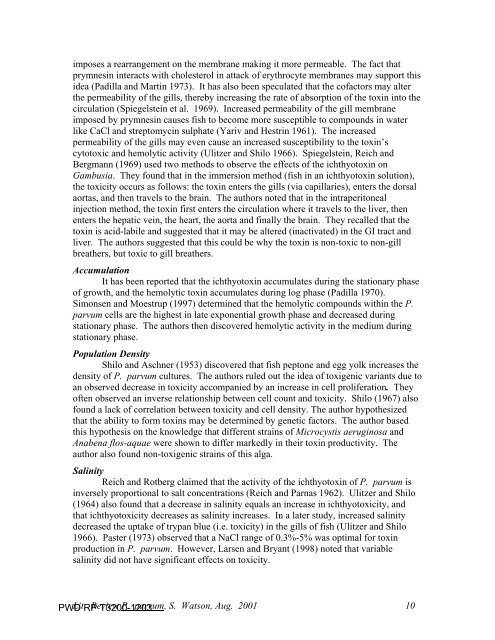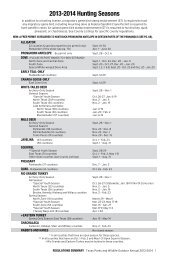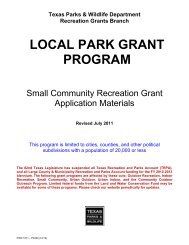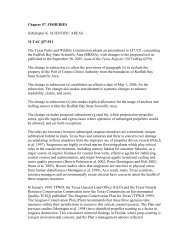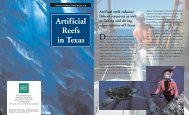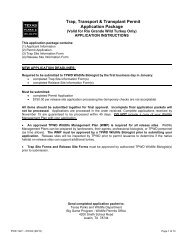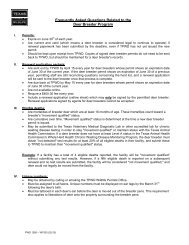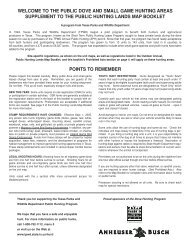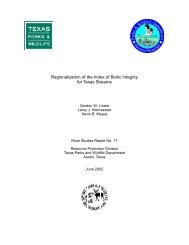- Page 1 and 2:
Golden Alga (Prymnesium parvum) Wor
- Page 3 and 4:
Golden Alga Workshop Agenda October
- Page 5 and 6:
Golden Alga Workshop Table of Conte
- Page 7 and 8:
Golden Alga Workshop Background Inf
- Page 9 and 10:
The TPWD “GOLD” Team Technical
- Page 11 and 12:
While There Is Much We Do Not Know
- Page 13 and 14:
Detection Early Simple Basic Resear
- Page 15 and 16:
Historical Review of Golden Alga (P
- Page 17 and 18:
Prymnesium parvum PWD RP T3200-1203
- Page 19 and 20:
Prymnesium parvum in Texas: 28 eve
- Page 21 and 22:
Five Texas River Basins Impacted C
- Page 23 and 24:
Number and Value of Fish Killed 198
- Page 25 and 26:
1 1 5 5 6 6 14 13 15 12 14 13 15 12
- Page 27 and 28:
Month Golden Alga Fish Kills Began
- Page 29 and 30:
Number of Fish Killed Brazos Basin
- Page 31 and 32:
We Want to Solve the Problem Factor
- Page 33 and 34:
What We Have Done - continued Repor
- Page 35 and 36:
Special Thanks To The Following: We
- Page 37 and 38:
Overview of Texas Hatchery Manageme
- Page 39 and 40:
Dundee State Fish Hatchery • Febr
- Page 41 and 42:
Dundee State Fish Hatchery • Caus
- Page 43 and 44:
TPWD Inland Fisheries P. parvum Tas
- Page 45 and 46:
TPWD Inland Fisheries P. parvum Tas
- Page 47 and 48:
Monitoring P. parvum densities •
- Page 49 and 50:
Monitoring Toxin Levels • Bioassa
- Page 51 and 52:
Monitoring of P. parvum • Needs -
- Page 53 and 54:
Physical Treatments Χ Sonication (
- Page 55 and 56:
Χ X Chemical Treatments Hydrogen p
- Page 57 and 58:
Treatments - Chemical • Ammonium
- Page 59 and 60:
Treatments - Chemical • Cutrine
- Page 61 and 62:
Achievements • Development of hat
- Page 63 and 64:
TPWD Inland Fisheries P. parvum Tas
- Page 65 and 66:
Phylogeny, life history, autecology
- Page 67 and 68:
Overview • morphology - what it l
- Page 69 and 70:
Morphology of P. parvum haptonema f
- Page 71 and 72:
Prymnesium species Species Habitat
- Page 73 and 74:
Haplo-diploid life cycle P. parvum
- Page 75 and 76:
Life cycle: mating experiment 2n +
- Page 77 and 78:
Possible life cycle for P. parvum H
- Page 79 and 80:
Optimum and tolerance for growth Pa
- Page 81 and 82:
Mixotrophy • P. parvum can ingest
- Page 83 and 84:
Toxins • proteolipids (Ulizur & S
- Page 85 and 86:
Occurrence of harmful Typical habit
- Page 87 and 88:
What can be done? • Establish a m
- Page 89 and 90:
Prymnesium parvum: An overview and
- Page 91 and 92:
Presently recognized Prymnesium spe
- Page 93 and 94:
Bloom History • Within a decade o
- Page 95 and 96:
PWD RP T3200-1203
- Page 97 and 98:
Dying Shad - Texas - courtesy of C.
- Page 99 and 100:
PWD RP T3200-1203
- Page 101 and 102:
Dead fish at a dam site in Texas -
- Page 103 and 104:
Fish showing hemmoragic areas from
- Page 105 and 106:
Toxins: (Lethal Cocktail) There is
- Page 107 and 108:
How easily can they be identified f
- Page 109 and 110:
PWD RP T3200-1203 Body Scales of P.
- Page 111 and 112:
Fluorescent labeled P. parvum cell
- Page 113 and 114:
Priorities: Cells: • accurate and
- Page 115 and 116:
Analysis of Prymnesium parvum bloom
- Page 117 and 118:
Overview • Questions Identified b
- Page 119 and 120:
Approach - proposed studies • Syn
- Page 121 and 122:
Lake Whitney Stations Site P11 Site
- Page 123 and 124:
80000 Lake Whitney 2003 P. parvum a
- Page 125 and 126:
Feb-April 2003 Lake Whitney: surfac
- Page 127 and 128:
Lake Bioassay Methods • Acclimate
- Page 129 and 130:
Lake Whitney Bioassay Sites Site P1
- Page 131 and 132:
Lake Whitney Nutrient Bioassay 4/29
- Page 133 and 134:
Original Questions • What factors
- Page 135 and 136:
Next steps? • Continue paired-res
- Page 137 and 138:
DY III Media Stock Addtions Nutrien
- Page 139 and 140:
Kill your enemies and eat them: the
- Page 141 and 142:
5 µm Killed salmons in aquaculture
- Page 143 and 144:
When will the first dead bathing gu
- Page 145 and 146:
PWD RP T3200-1203
- Page 147 and 148:
Toxicity in Chrysochromulina polyle
- Page 149 and 150:
HE 50 (10 6 cells ml -1 ) Prymnesiu
- Page 151 and 152:
Effect of increasing P-deficent P.
- Page 153 and 154:
Ichthyotoxic species Prymnesin-2 H
- Page 155 and 156:
☺ Before PWD RP T3200-1203
- Page 157 and 158:
Effect of Prymnesium parvum filtrat
- Page 159 and 160:
Skovgaard and Hansen, 2003, L & O,
- Page 161 and 162:
Ciliates Flagellates Diatoms cell l
- Page 163 and 164:
Low Prymnesium parvum cell numbers
- Page 165 and 166:
6 Bacterivory in P. parvum Ingested
- Page 167 and 168:
P. parvum phagotrophy (prey ingesti
- Page 169 and 170:
% P. parvum feeding cells and lysed
- Page 171 and 172:
Skovgaard and Hansen, 2003, L & O,
- Page 173 and 174:
Oxyrrhis marina cell lysis in the p
- Page 175 and 176:
Ingestion of Oxyrrhis after 2 and 6
- Page 177 and 178:
P-deficient P. parvum ingesting blo
- Page 179 and 180:
Conclusions •Toxicity is the key
- Page 181 and 182:
C. helgolandicus pellets •Picture
- Page 183 and 184:
Laboratory Studies on Prymnesium -
- Page 185 and 186:
News Release • May 28, 2002 - mas
- Page 187 and 188:
Fish Kill at Prewitt Reservoir PWD
- Page 189 and 190:
Pelicans putative of transport agen
- Page 191 and 192:
Objectives of this Presentation •
- Page 193 and 194:
Prymnesium Strains in Culture • U
- Page 195 and 196:
Structure of Prymnesium PWD RP T320
- Page 197 and 198:
PWD RP T3200-1203
- Page 199 and 200:
Scales Haptonema PWD RP T3200-1203
- Page 201 and 202:
Cyst Formation • A variety of con
- Page 203 and 204:
Growth Observations 0n Prymnesium s
- Page 205 and 206:
Prymnesium Twin Buttes Lake, Wyomin
- Page 207 and 208:
Hemolytic Bioassay Procedures • 5
- Page 209 and 210:
Hemolysis Bioassay • Alga Medium
- Page 211 and 212:
Mixotrophy Studies • Several phyt
- Page 213 and 214:
Chloroplast Endoplasmic Reticulum N
- Page 215 and 216:
Adaptive Advantage of Chloroplast E
- Page 217 and 218:
10 µm Kathablepharis sp. Courtesy
- Page 219 and 220:
Chrysochromulina parva Long, uncoil
- Page 221 and 222:
Ingested Chrysochromulina & some ba
- Page 223 and 224:
Return to Prewitt • Prymnesium pa
- Page 225 and 226:
Prewitt Reservoir Fact • Five day
- Page 227 and 228:
Prewitt Reservoir Explanation • P
- Page 229 and 230:
Prewitt Mystery Solved? • Campylo
- Page 231 and 232:
Future Prymnesium Problems in Wyomi
- Page 233 and 234:
Rapid Tests for the Detection of Pr
- Page 235 and 236:
Why rRNA probes? * universally foun
- Page 237 and 238:
PWD RP T3200-1203
- Page 239 and 240:
EUK 1209R CHLO 02 PRYM 02 PELA 01 P
- Page 241 and 242:
Change from PFA to ETOH Saline Chan
- Page 243 and 244:
Analysis of Alexandrium strains fro
- Page 245 and 246:
PWD RP T3200-1203
- Page 247 and 248:
Harmful Algal Blooms Noctiluca Kare
- Page 249 and 250:
PWD RP T3200-1203 Coccolithus pelag
- Page 251 and 252:
Application & detection methods for
- Page 253 and 254:
Conclusions • Specific probes cou
- Page 255 and 256:
1. ChemScanRDI, a laser based syste
- Page 257 and 258:
ChemScanRDI combines fluorescent ce
- Page 259 and 260:
Electrochemical detection of toxic
- Page 261 and 262:
Electrochemical Detection of rRNA f
- Page 263 and 264:
Comparison of cell counts with elec
- Page 265 and 266:
Long term stability of treated sens
- Page 267 and 268:
Development of DNA-microarrays for
- Page 269 and 270:
Scheme of a DNA-Chip Experiment Flu
- Page 271 and 272:
Monitoring Phytoplankton compositio
- Page 273 and 274:
EUK 1209 CHLO01 Localization of the
- Page 275 and 276:
Identification of Phytoplankton on
- Page 277 and 278:
DNA CHIP Clone librairy Dec 2000 1
- Page 279 and 280:
Research Needs • Monitoring of to
- Page 281 and 282:
Rapid Tests for the Detection of Ha
- Page 283 and 284:
abs. units 1.0 0.8 0.6 0.4 0.2 y =
- Page 285 and 286:
Prymnesium parvumRL10 % lysis 100 8
- Page 287 and 288:
PWD RP T3200-1203 Allelochemical ef
- Page 289 and 290:
Controlling Harmful Algal Blooms Do
- Page 291 and 292:
Management of harmful algae • Pre
- Page 293 and 294:
Chemical control of freshwater alga
- Page 295 and 296:
•This (small) reservoir had a lon
- Page 297 and 298:
Chemical flocculants - Phosphorus C
- Page 299 and 300:
PWD RP T3200-1203 from: River Scien
- Page 301 and 302:
Biological Control - Viruses Aureoc
- Page 303 and 304:
Viruses for HAB species Target spec
- Page 305 and 306:
Biological Control - Bacterial path
- Page 307 and 308:
Biological Control - Grazers Target
- Page 309 and 310:
Clay control of HAB species clay mi
- Page 311 and 312:
Variable removal ability of domesti
- Page 313 and 314:
PWD RP T3200-1203 Source: Sengco et
- Page 315 and 316:
Flume studies, WHOI PWD RP T3200-12
- Page 317 and 318:
Brevetoxin analysis cell concentrat
- Page 319 and 320:
Impacts - Benthic fauna Archambault
- Page 321 and 322:
Future directions: Cell removal, se
- Page 323 and 324:
When the cells reached exponential
- Page 325 and 326:
Conclusions Kalmar Experiments Phos
- Page 327 and 328:
Experiments at Woods Hole (in colla
- Page 329 and 330:
Recent work in Kalmar (data from J.
- Page 331 and 332:
Conclusions - control of Prymnesium
- Page 333 and 334:
A review of fish-killing microalgae
- Page 335 and 336:
Toxic/harmful microalgae • dinofl
- Page 337 and 338:
PWD RP T3200-1203 Fish kills
- Page 339 and 340:
Ichthyotoxic species • Karenia br
- Page 341 and 342:
FMRI,FWC Exposure routes • gills
- Page 343 and 344:
Gymnodinium pulchellum (brevetoxins
- Page 345 and 346:
Reef fish disease - Caribbean, Flor
- Page 347 and 348:
Diatoms • physical damage to gill
- Page 349 and 350:
Aquaculture in Israel and Prymnesiu
- Page 351 and 352:
Prymnesium parvum from Israel PWD R
- Page 353 and 354:
Prymnesium parvum blooms in Israel
- Page 355 and 356:
From Sarig 1971 Prymnesium parvum t
- Page 357 and 358:
From Sarig 1971 Mode of toxin actio
- Page 359 and 360:
Fish bioassay • dependence of tox
- Page 361 and 362:
Relationship # toxin concentration
- Page 363 and 364:
From Sarig 1971 Management of Prymn
- Page 365 and 366:
Management strategies • prevent b
- Page 367 and 368:
How to Use the Past to Plan for the
- Page 369 and 370: How can studies on other harmful al
- Page 371 and 372: Task Force report identified 7 HAB
- Page 373 and 374: A 5-year federal, state, academic,
- Page 375 and 376: ECONOMIC IMPACT In the 1970s, two r
- Page 377 and 378: What is Needed Based on What is Kno
- Page 379 and 380: What is Needed Based on What is Kno
- Page 381 and 382: What is Needed Based on What is Kno
- Page 383 and 384: Golden Alga Workshop Notes: Present
- Page 385 and 386: facilities was a problem in North C
- Page 387 and 388: Korean fisheries are a $1 billion i
- Page 389 and 390: Friday October 24, 2003 Panel Discu
- Page 391 and 392: • Design a sampling program with
- Page 393 and 394: What are your recommendations for i
- Page 395 and 396: • Rapid progress is made where th
- Page 397 and 398: • Maintain a Golden Alga web site
- Page 399 and 400: ChemScanRDI (a laser based system t
- Page 401 and 402: • DNA-microarrays for monitoring
- Page 403 and 404: • Reliable economic statistics fo
- Page 405 and 406: • Be proactive; get messages out
- Page 407 and 408: Golden Alga Workshop Attendees Firs
- Page 409 and 410: Golden Alga Workshop Attendees, con
- Page 411 and 412: Literature Review of the Microalga
- Page 413 and 414: Oued Mellah Reservoir in Morocco oc
- Page 415 and 416: the metal ions Fe, Zn, Mo, Cu or Co
- Page 417 and 418: with the ability to utilize organic
- Page 419: Figure 1. Prymnesin-1 (1) and Prymn
- Page 423 and 424: Glycerol Glycerol was found to incr
- Page 425 and 426: since it seems that nitrogen and ph
- Page 427 and 428: (Haptophyta) in semi-continuous cul
- Page 429: Ulitzer, S. and M. Shilo. 1966. Mod


